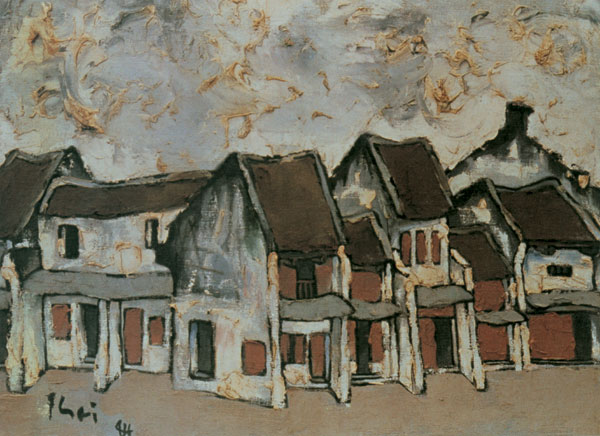Bui Xuan Phai (September 1st, 1920 – June 24th, 1988) is a well-known Vietnamese painter; especially he is famous for the paintings of Hanoi Old Quarters (Phai’s street).[image src=”https://www.hanoiarttours.com/wp-content/uploads/2016/06/Bui_Xuan_Phai.jpg” width=”220″ height=”306″]
Artist Bui Xuan Phai (1920 – 1988)
He was born in Kim Hoang village, Van Canh commune, Ha Dong province (Hanoi, Vietnam). He graduated from the Painting Section of the École Supérieure des Beaux-Arts d’Indochine (1941-1945 class) and joined the Resistance and many group exhibitions. In 1952, he returned to Hanoi, lived and worked at No. 87 Thuoc Bac until his death. From 1956 to 1957, Bui Xuan Phai became a teacher at the Hanoi Fine Arts College. When taking part in Humanism – Belles Lettres movement, he had reeducation through labor at a joinery workshop in Nam Dinh, at the same time; the administrator of the Fine Arts College suggested a resignation to him.
[image src=”https://www.hanoiarttours.com/wp-content/uploads/2016/06/Dye-Workshop-1985.jpg” width=”653″ height=”490″]Dye Workshop (Phan xuong nhuom), pigments, 1985
Bui Xuan Phai is a student of the last generation of the École Supérieure des Beaux-Arts d’Indochine, together with Nguyen Sang, Nguyen Tu Nghiem, Duong Bich Lien – hugely influential painters on the evolution of Vietnamese modern art. His specialties were oil painting and his favorite matter was Hanoi old quarter. As early as in his lifetime, his works – Pho Phai (Phai street) are admired by art-loving people. Bui Xuan Phai’s streetscapes are not only antique but realistic as well, successfully conveys the soul of Hanoi old quarter in the 1950’s, 1960’s and 1970’s. The outlines of his paintings are deeply marked, hence, the street not only expresses itself, but also becomes closer to viewers; both the painted surface and the surroundings convey an inner depth. Throughout his streetscapes, the viewers may realize that the artist showed his affectionate memories combined with sincere regrets and vague sorrow in every brushstroke, like a sign of the abrupt disappearance of roofs and people that bring the soul of the past. Besides the old quarter, he also constituted considerable achievements in other matters such as cheo, portraits, rural landscapes, nudes, still lives. Many of his works won prizes at national and capital art exhibitions. He painted on canvases, paper, cardboard, wooden plates, even on newsprint when he lacked materials and used a variety of tools such as oil, watercolor, pastel, charcoal, crayon. His paintings vividly convey the Vietnamese people’s soul, humanist character, love of freedom, humor, tragic and miserableness. He offered a substantial contribution in the area of illustration for newspaper and book cover design and in 1982, he won an international prize (Leipzig) for his design of the book He Cheo.
Make-up Before a the Show – 1984
From 1957 onward, his activities had been gradually restricted, resulting from his participation in Humanism – Belles Lettres movement. In order to earn a living, he had to take orders for illustrations as well as comics for newspapers under the name of PiHa, ViVu, Ly.
Signature of Bui Xuan Phai
It was not until 1984 that he had his own solo exhibition highly appreciated by both his colleagues and the public. With 24 pictures that were immediately ordered in the opening, this had been considered to be the most successful exhibition so far in Vietnam. That was also the first time that the central television attached a great deal of time to introduce Bui Xuan Phai’s life and work in the program named Literature and Art.[image src=”https://www.hanoiarttours.com/wp-content/uploads/2016/06/Hang-Man-Street-1984.jpg” width=”600″ height=”436″]
Hang Mam Street – 1984
Despite facing a difficult life, thanks to his eternal love for art and passion for displaying daily simple beauty with emotional depths, Bui Xuan Phai was constantly drawing and creating, even when he could not purchase painting materials and had to take advantage of materials such as cigarette packs and newspapers. He was also the artist who got rid of everyday worries to create the simple but consciously artistic. In 1996, he was awarded Ho Chi Minh prize.
Remarkable Art Works:
Hanoi Old Quarter – Oil paint (1972)
Hanoi in Resistance – Oil paint (1966)
An Ox Cart in Old Quarter – Oil paint (1972)
Deserted Street – Oil paint (1981)
Make-up Before a Cheo Representation – Oil paint (1968)
A Cheo Stage – Oil paint (1968)
A Cheo Couple – Oil paint (1967)
Make-up Before a the Show – Oil paint (1984)
Art Prizes and Awards:
Ho Chi Minh Prize in Literature and Arts, 1996
Prizes at the 1946 and 1980 National Art Exhibitions
Prize at the International Graphic Exhibition in Leipzig (Germany)
Prizes at the 1969, 1981, 1983 and 1984 Capital City Art Exhibitions
Medal “For Vietnamese Art”, 1997.



